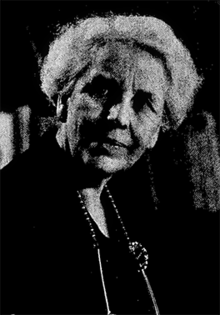Norma Ford Walker
Norma Ford Walker (September 3, 1893 – August 9, 1968) was a Canadian scientist who pioneered the development of medical genetics as a research field. Though she began her academic career as an entomologist, working as an invertebrate zoologist at the University of Toronto, she became interested in medical genetics in the 1930s, and researched the medical genetics of the then famous Dionne Quintuplets. She was an original founding member of the American Society of Human Genetics and between 1947 and 1962, was the first director of the Department of Genetics at what was then the Toronto Hospital for Sick Children.[2] She was a strong advocate for women in science, and supervised many women would later become the first appointed department heads of human genetics at many Canadian universities.[2] Her academic career spanned six decades and she published prolifically in both human genetics and entomology. She was elected a Fellow of the Royal Society of Canada in 1958.
Norma Ford Walker | |
|---|---|
 | |
| Born | Norma Henrietta Carswell Ford[1] September 3, 1893 |
| Died | August 9, 1968 (aged 74) |
| Citizenship | Canadian |
| Alma mater | University of Toronto |
| Known for | Genetic Counseling, Research on the Dionne Quintuplets |
| Spouse(s) | Edmund Murton Walker |
| Scientific career | |
| Fields | Medical Genetics,Entomology,Dermatoglyphics |
| Institutions | Toronto Hospital for Sick Children |
| Thesis | A Comparative Study of the Abdominal Musculature of Orthopteroid Insects (1923) |
| Doctoral advisor | Edmund Murton Walker |
| Doctoral students | Irene Uchida |
| Influenced | Oliver Smithies |
Life and work
Norma Henrietta Carswell Ford was born September 3, 1893 at St Thomas, Ontario to Norman W. Ford and Margaret Henrietta Dyke[3] She entered into a BA degree at the University of Toronto in 1914 and completed her PhD in zoology there in 1923, under the supervision of Edmund Murton Walker.[4] In the late 1910s, prior to completing her PhD, she taught biology classes for women and throughout the 1920s she would give lectures on biology, health, and human genetics to various women's groups including the Girl Guides.[2]
Her early work was in invertebrate zoology, and in addition to her thesis (completed in 1923), she published several papers on the physiology and behaviour of the Grylloblatteria and the sarcophagid fly, Wohlfahrtia[5][6][7][8] In 1937, she was co-principal investigator on a study tasked with determining whether the Dionne Quintuplets were truly genetically identical,[9] and left entomology behind. In 1943, she married Edmund Walker.
Between 1937 and her death she made many valuable contributions to the study of human genetics, and became a globally-renowned expert on multiple births. She was the first person to apply dermatoglyphics in the diagnosis of Down syndrome.[10]
She taught Oliver Smithies genetics in her lab[11] and with him, demonstrated that haptoglobin types were inherited[12][13]
In 1966, she was awarded an honorary degree from Queen's University, Kingston for her scientific achievements.
References
- Miller, Fiona (2008). "Remembering Norma Ford Walker (1893–1968)". Genome. 51 (12): vii–viii. doi:10.1139/g08-915.
- Miller, Fiona (2002). "The Importance of Being Marginal: Norma Ford Walker and a Canadian School of Medical Genetics". American Journal of Medical Genetics. 115 (2): 102–110. doi:10.1002/ajmg.10544. PMID 12400056.
- ""Ontario Births, 1869-1912," database with images". FamilySearch.
- Thompson, Margaret (1968). "Norma Ford Walker 1893-1968". Canadian Journal of Genetics and Cytology. 10 (4): i–ii. doi:10.1139/g68-095.
- Ford, Norma (1936). "urther observations on the behaviour of Wohlfahrtia vigil (Walk.) with notes on the collecting and rearing of the flies". Journal of Parasitology. 22: 309–328. doi:10.2307/3271857.
- Ford, Norma (1932). "bservations on the behaviour of the Sarcophagid fly, Wohlfahrtia vigil". Journal of Parasitology. 19: 106–111. doi:10.2307/3271610.
- Ford, Norma (1925–1926). "On the behaviour of Grylloblata". Canadian Entomologist. 58: 66–70. doi:10.4039/ent5866-3.CS1 maint: date format (link)
- Ford, Norma. A comparative study of the abdominal musculature of orthopteroid insects (PhD Dissertation ed.). University of Toronto.
- MacArthur, J.; Ford, N. Blatz, WE (ed.). "A biological study of the Dionne quintuplets: an identical set". Collected studies on the Dionne quintuplets. University of Toronto Press: 3–49. Cite journal requires
|journal=(help) - Ford Walker, Norma (1957). "The use of dermal configurations in the diagnosis of Mongolism". Journal of Pediatrics. 50: 19–26. doi:10.1016/s0022-3476(57)80005-5.
- Dronamraju, Krishna (1992). History And Development Of Human Genetics, The: Progress In Different Countries. World Scientific. p. 6. ISBN 9789814555210.
- Smithies, O.; Ford Walker, N. (1956). "Notation for serum-protein groups and the genes control- ling their inheritance". Nature. 178: 694–695. doi:10.1038/178694a0.
- Smithies, O.; Ford Walker, N. (1955). "Genetic control of some serum proteins in normal humans". Nature. 178: 1265–1266.